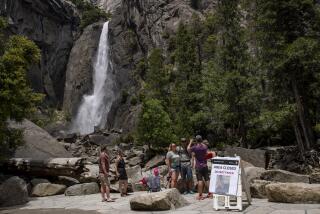Yosemite boosts the awe factor
Visitors to one of the world’s best-known sets of waterfalls are finding improved trails, new bridges and an amphitheater and other facilities designed to immerse them in the forest environment.
Although the $13.5-million restoration of the 52-acre Yosemite Falls area of California’s Yosemite National Park won’t be dedicated until April, most of the construction is finished.
The project designer was Lawrence Halprin, one of the country’s top landscape architects, whose works include the FDR Memorial in Washington, D.C., and the Bunker Hill steps in downtown Los Angeles.
The goal at Yosemite is to inspire the falls’ 3 million annual visitors to linger for more than a quick photo opportunity, said Bob Hansen, president of the Yosemite Fund, a private nonprofit group that financed most of the project.
Early reports suggest that goal is being reached.
“People walk through it as if it’s a cathedral in Europe,” Hansen said of those who follow the reconstructed eastern trail at the base of Lower Yosemite Falls.
The trail is wheelchair-accessible, affording those with disabilities easy access to the main bridge at the viewing area. Benches and alcoves provide rest spots along the way.
Visitors will find a stone amphitheater off the main trail and interpretive signs and exhibits tracing Yosemite’s natural history and 4,000 years of Indian culture, including a bronze relief map of the falls area for sight-impaired travelers.
A former parking lot has become open space and a picnic area, and a larger wood-and-stone structure has replaced the former cinder-block restrooms. There’s also a new shuttle stop for the park’s transit system.
The Yosemite Falls restoration, under construction since June 2002, with finishing touches completed over the last few weeks, is the most expensive project undertaken by the 16-year-old Yosemite Fund, which has raised more than $30 million for park improvements.
For its next endeavor, Hansen said, his organization would like to develop exhibition space for the park’s more than 2 million artifacts, most of which are in storage. They include Native American items, early photography and personal effects of pioneering naturalist John Muir.
For more information about Yosemite, visit www.nps.gov/yose.
More to Read
Sign up for The Wild
We’ll help you find the best places to hike, bike and run, as well as the perfect silent spots for meditation and yoga.
You may occasionally receive promotional content from the Los Angeles Times.






